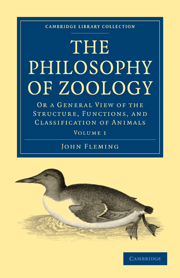 The Philosophy of Zoology
The Philosophy of Zoology Book contents
- Frontmatter
- Preface
- Contents
- Divisions of Natural Science
- CHAP. I Division of Natural Objects into Organised and Inorganic. The Chain of Being
- CHAP. II Peculiar Characters of Organised Bodies
- CHAP. III Distinguishing Characters of Animals and Vegetables
- CHAP. IV On the Polity of Nature
- CHAP. V On the Substances which enter into the Composition of the Bodies of Animals
- CHAP. VI Cutaneous System
- CHAP. VII Osseous System
- CHAP. VIII Muscular System
- CHAP. IX Nervous System
- CHAP. X Organs of Perception
- CHAP. XI Faculties of the Mind
- CHAP. XII Digestive System
- CHAP. XIII Circulating System
- CHAP. XIV Peculiar Secretions
- CHAP. XV Reproductive System
CHAP. III - Distinguishing Characters of Animals and Vegetables
Published online by Cambridge University Press: 29 August 2010
- Frontmatter
- Preface
- Contents
- Divisions of Natural Science
- CHAP. I Division of Natural Objects into Organised and Inorganic. The Chain of Being
- CHAP. II Peculiar Characters of Organised Bodies
- CHAP. III Distinguishing Characters of Animals and Vegetables
- CHAP. IV On the Polity of Nature
- CHAP. V On the Substances which enter into the Composition of the Bodies of Animals
- CHAP. VI Cutaneous System
- CHAP. VII Osseous System
- CHAP. VIII Muscular System
- CHAP. IX Nervous System
- CHAP. X Organs of Perception
- CHAP. XI Faculties of the Mind
- CHAP. XII Digestive System
- CHAP. XIII Circulating System
- CHAP. XIV Peculiar Secretions
- CHAP. XV Reproductive System
Summary
Having endeavoured to ascertain those characters which are common to all organized bodies, it now remains that we mark the limits which separate these into the two great kingdoms of Animals and Vegetables, into which they have been divided by the universal consent of mankind. The undertaking may be regarded as peculiarly difficult, if we judge from the variety of definitions which have been given, and the still unsettled state of opinion among naturalists ou the subject. Part of this difficulty, however, may be referred to the employment of ambiguous phrases, and to inattention to the number and character of those properties which are common equally to plants and animals. But the greatest share may be traced to the practice of examining the doubtful objects, without attending to all their relations,–by comparing the less perfect animals with some of the qualities of the most perfect plants, and by allowing our opinions to be influenced by circumstances connected with mere size and form.
When we compare together those animals and plants, which are considered as occupying the highest stations in each kingdom, we perceive that the characters by which they may be distinguished, are obvious and well defined. But when we descend to the animals and plants which occupy the lowest stations, and perceive that they are less complicated in their structure; exercise few functions besides those which are essential to living bodies; and, in consequence, present only obscure points of difference, we may be led into the supposition that, at a certain link of the chain, the two kingdoms coalesce.
- Type
- Chapter
- Information
- The Philosophy of ZoologyOr a General View of the Structure, Functions, and Classification of Animals, pp. 39 - 48Publisher: Cambridge University PressPrint publication year: 2009First published in: 1822


